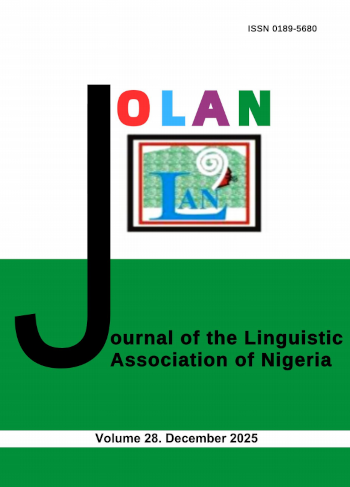Beyond connectives in Ngwa
DOI:
https://doi.org/10.60787/jolan.vol27no1-2.388Keywords:
Conjunction, Coordinating, Conjunct, Subordinating, SyntaxAbstract
Connectives are a grammatical category in many languages of the world which serve to link constituent structures together. Connectives exhibit varied morphological forms and are used to perform different functions in the languages. The goal of this paper is to describe the forms, functions, and general characteristics of connectives in Ngwa dialect of Igbo. The primary and secondary data were collected through elicitation and written materials, respectively. The Xʹ model of syntactic analysis was used in the discussion because it helps to establish the structural link between the heads of a construction and their dependants. The study identified more than eight words used to conjoin structures in the dialect. All the conjoining elements have basic CV syllable structure, with an initial consonant (or a syllabic nasal) followed by either a low tone open vowel /à/ or a high tone back vowel /ú/.
Connectives cannot appear in sentence final positions where they introduce no clause, and the coordinating conjunction, là ‘and’ cannot be used in sentence initial position. Some conjoining words like là ‘and’, mà ‘or’, perform overlapping functions based on the type of structures they conjoin hence each can be used as coordinating and subordinating conjunction. This study is relevant in contributing to the body of literature in Ngwa dialect.
References
Carnie, A. (2007). Syntax: A generative introduction. Blackwell Publishing.
Chomsky, N. (1970). Remarks on nominalisation. In R. Jacobs and P. Rosenbaum (Eds.). Readings in English transformational grammar. MIT Press.
Dik, S. C. (1968). Coordination: Its implications for the theory of general linguistics. North Holland.
Emenanjo, E. N. (1978). Elements of modern Igbo grammar. Oxford University Press.
Ezeomeke, S. O. (1999). Igodo nghota utoasusu Igbo. Easy Quality Press.
Hudson, R. A. (1987). Zwicky on heads. Journal of Linguistics, 23, 109-32.
Igwe, G. T. & Green, N. N. (1964). A short Igbo grammar in the official Igbo orthography. Oxford University Press.
Johannessen, J. (1998). Coordination. Oxford University Press.
Kambon, O. (2012). Conjunctions in Yoruba. Available at http:www.abitumikasa.com/forums/Yoruba_language_resources/48072_conjunctions yoru_ba.html. Accessed 26/06/2017.
Kammelu, N. C., Onumaegbu, C. M., Nnadi, C. C., Chukwu, O. A., Umeh, I. E. (2002). Ntoala omumu asusu Igbo. Love and Peace Press Ltd.
Kirkpatrick, B. (2010). Correct grammar, correct English. Waverly Books.
Mbah, B. M. (2011). GB Syntax: A minimalist theory and application to Igbo. Enugu: CIDJAP Press.
Ndimele, O -M. (1992). Parameters of universal grammar: Government and Binding approach. African Educational Services, Ltd.
Ndimele, O –M. (2003). A concise grammar and lexicon of Etchie. National Institute for Nigerian Languages.
Ofomata, C. E. (2005). Ndezu utoasusu Igbo nke ndi junio sekondiri. Format Publishers Ltd.
Ogbonna, A. (2009). The syntax and semantics of Igbo preposition and prepositional phrase. USEM Journal of Languages, Linguistics and Literature, 2, 26-41.
Okonkwo, M. N. (1974). A complete course in Igbo grammar. Academy Press Ltd.
Ume, I. A. O, Ugorji, J. U. & Dike, G. A. (1989). Umi nkowa utoasusu Igbo. Kawuriz & Manilas Publishing Ltd.
Downloads
Published
How to Cite
Issue
Section
License
Copyright (c) 2024 Journal of The Linguistic Association of Nigeria

This work is licensed under a Creative Commons Attribution-NonCommercial-ShareAlike 4.0 International License.













